History of the Twelve Colonies: Difference between revisions
More actions
| Line 15: | Line 15: | ||
This prior knowledge is also consistent with the portions of the [[Sacred Scrolls]] revealed to us thus far, and the veneration of the [[Religion in the Twelve Colonies#The Lords of Kobol|Lords of Kobol]], whose resemblance to the Greek Gods cannot otherwise be easily accounted for. The Colonial [[Life Forms of the Twelve Colonies|ecosystems]] are also identical to Earth's, with very few exceptions.<ref>In the DVD commentary for the [[Miniseries]], [[Ron Moore]] and [[David Eick]] indicate that they deliberately confuse the storyline so that it is impossible to know if the Re-imagined Series takes place in the past, present, or future of the real-world Earth of today.</ref> | This prior knowledge is also consistent with the portions of the [[Sacred Scrolls]] revealed to us thus far, and the veneration of the [[Religion in the Twelve Colonies#The Lords of Kobol|Lords of Kobol]], whose resemblance to the Greek Gods cannot otherwise be easily accounted for. The Colonial [[Life Forms of the Twelve Colonies|ecosystems]] are also identical to Earth's, with very few exceptions.<ref>In the DVD commentary for the [[Miniseries]], [[Ron Moore]] and [[David Eick]] indicate that they deliberately confuse the storyline so that it is impossible to know if the Re-imagined Series takes place in the past, present, or future of the real-world Earth of today.</ref> | ||
Several clues point to Earth as the true homeworld of humanity. As the Fleet approaches Earth, the artifacts they encounter are more recent. The ruins on Kobol were 2,000 years old, the Horsehead Nebula Beacon was 3,000 years old, and the Temple of Five was dated to 4,000 years old. | |||
==Kobol== | ==Kobol== | ||
Revision as of 23:26, 28 June 2007
- This article discusses an aspect of the Re-imagined Series version of the Twelve Colonies. For information on the Original Series version, see The Twelve Colonies (TOS).
- See also the Re-Imagined Series Timeline for an approximate chronology of the history of the Colonies and events in the Re-imagined Series.
| Part of the series on | ||||||||||||
|
| ||||||||||||
Pre-History
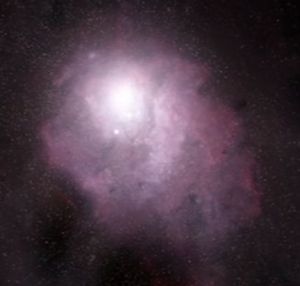
During the service for the dead at the conclusion of the Miniseries, William Adama states "Life here began out there,"[1] reminding the assembly that this was the first line of the Sacred Scrolls, told to them by the Lords of Kobol uncounted centuries ago.
There is some evidence that appears to indicate that the humans of Kobol actually originated from the planet Earth.[2]
When a ground team from the Fleet enters the Tomb of Athena, they find a map room in the form of a planetarium, depicting constellations in Earth's night sky. Laura Roslin identifies the actual star patterns, not their symbols, as the original flags of the Twelve Colonies. These patterns are only visible from Earth, which implies that the creators of the map had some prior knowledge of their destination before setting out (Home, Part II).
This prior knowledge is also consistent with the portions of the Sacred Scrolls revealed to us thus far, and the veneration of the Lords of Kobol, whose resemblance to the Greek Gods cannot otherwise be easily accounted for. The Colonial ecosystems are also identical to Earth's, with very few exceptions.[3]
Several clues point to Earth as the true homeworld of humanity. As the Fleet approaches Earth, the artifacts they encounter are more recent. The ruins on Kobol were 2,000 years old, the Horsehead Nebula Beacon was 3,000 years old, and the Temple of Five was dated to 4,000 years old.
Kobol
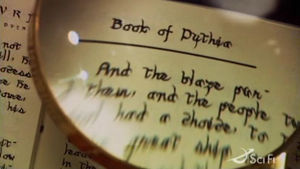
Approximately 3,600 years before the events in the Miniseries, the oracle Pythia recorded her prophecy of the exile and rebirth of the human race (The Hand of God).
While on Kobol, the thirteen tribes apparently lived in an idyllic utopia with their Gods, but roughly 1,600 years later (2,000 years before the Fall of the Twelve Colonies), this coexistence was ended as Pythia's prophecy came to fruition (Kobol's Last Gleaming, Part I). The prophecy alludes to a "blaze" which descended on the thirteen tribes and against which the Lords of Kobol were powerless to intervene (Home, Part I).[4]
Exodus

In despair, Athena threw herself from the Gates of Hera, to her death. The leaders of the tribes were interred with her, and the populace of the tribes were taken in a "Galleon" (a spacecraft) to their places of refuge. Twelve tribes find and occupy a solar system with at least 12 habitable worlds, while a thirteenth tribe locates a world they named Earth. Zeus warned the survivors that any return to Kobol "would exact a price in blood."
Settlement
After settling on their new homes, another cataclysm befell the Twelve Tribes. This resulted in the destruction of much of their knowledge base and sent the Colonies into a dark age [5][6].

After their return to space, the Colonies established many observatories, listening posts, research stations and armories in their system. Inequity and war were common between the Colonies for most of this time period as each colony behaved more as soverign nations. By the end of the strife, Sagittaron had been exploited for centuries (Bastille Day).
Various shifting alliances and attempts at unified government came out of these conflicts, which would later form the bedrock of the Articles of Colonization, but it would still be some time before a practical Colonies-wide government was established [7].
The Colonials also created robots, called Cylons, to do work which they found unpleasant, including industrial work and soldiers in their civil wars.[5]
The Cylon War
- Main article: Cylon War
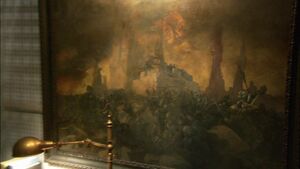
Such was the extent to which the Colonies had invested their military power in the Cylons that when they chose to rebel against their masters, the Colonials found themselves well-matched. With their mastery of Colonial technology, the Cylons were able to infiltrate nearly all networked devices. The Colonials were forced to abandon networked computers and wireless devices in favor of more secure and durable technologies, able to withstand both Cylon infiltration and the powerful nuclear weapons used by the warring parties[8]. Twelve battlestars built in the opening years of the war best exemplified these principles, including Galactica (Miniseries). In response to the great threat posed by the Cylons, the Twelve Colonies formed a unified federal Government for the first time, at the beginning of the war (Colonial Day).
At its darkest hour, the Cylon War came very close to wiping out the Colonies.[5] This outcome of the war likely developed, among other practices, the Case Orange contingency government succession protocol as well as the re-buildup of the Colonial Fleet in the Federal Era.
Armistice
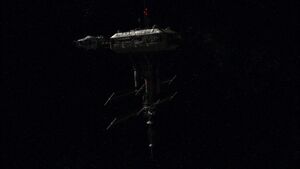
After the Cylon War ended, a long and bloody struggle of approximately 12 years, an armistice was declared, and the Cylons departed for a world of their own. The Colonials established a neutral meeting place, Armistice Station, and made diplomatic overtures for Cylons and Colonials to meet annually. However, these overtures were continually ignored.
After the war, the military went through a Reduction in Force, resulting in the discharge of many of the war's veterans.
Federal Era
While the Cylon War had a lasting effect on the government of the Twelve Colonies, the population as a whole, much of it born after the war, had relegated it to a historical note in textbooks (much as real-world Earth citizens regard their Second World War). The now-united government continued to maintain a large standing military, which, forty years after the war, had grown to include 120 battlestars (Miniseries), most apparently more advanced than those of the original battlestar class (Pegasus). This buildup apparently began about twenty years after the war, around the time Saul Tigh and William Adama rejoined the military ("Scattered" and its podcast).
With their military assets now concentrated in a central government under the Articles of Colonization (with Caprica City as the capitol), the new government of the Twelve Colonies was able to maintain peace among its members (Water). Now presumably free of the Cylon threat, technologies which could not be used during the war were redeployed throughout the fleet, increasing its effectiveness against more mundane opponents (Miniseries).
This new era of federalism was not without considerable opposition. Dissidents on Sagittaron lead by Tom Zarek took arms against the government (Bastille Day), supplied by arms dealers like Leoben Conoy.[5] Regardless of these localized attempts at insurrection, on the whole the Twelve Colonies faced no major military threats, with the loss of contact with the Cylons. The Colonial Fleet's standing numbers were actually kept disproportionately high relative to their common uses, in fear that one day the Cylons might return. Day-to-day work for the Fleet consisted of handling the small-scale brush fire attempts at rebellion such as on Sagittaron, but these were all light peacekeeping actions rather than actual fighting. Prior to the Cylon attack, none of Galactica's younger-generation crew had ever seen any real combat.
Fall of the Twelve Colonies
- Main article: Fall of the Twelve Colonies
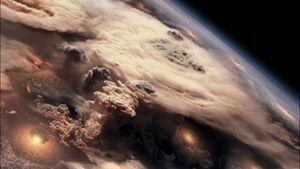
The arrogance of the Colonials in re-equipping their military with technologies vulnerable to Cylon interference proved to be their undoing. Forty years after the first Cylon War, Cylon infiltrators subverted Dr. Gaius Baltar's Command Navigation Program, allowing an advanced Cylon armada to destroy the Colonial fleet with impunity.
The attack resulted in the nuclear bombardment and occupation of the Colonies and the enslavement of most of the few isolated survivors in a series of Farms. Altogether, less than one hundred ships (mostly civilian) survived the attack, including only two battlestars - the nearly obsolete Galactica and the Mercury class battlestar Pegasus. The survivors abandoned the Colonies and formed a convoy in search of the thirteenth colony, Earth, where they hope to find refuge.
References
- ↑ This line is an homage to the Original Series, where each episode began with a voiceover of this phrase.
- ↑ For the most part, the similarities between the culture of the Twelve Colonies and Earth (three piece suits, Humvees, military jargon, firearms, etc.) are presumably dramatic conceits intended to help the audience identify with the characters of the show. The series, however, is written to exhibit evidence of a prior connection with Earth's past, present or future colonization by humanity.
- ↑ In the DVD commentary for the Miniseries, Ron Moore and David Eick indicate that they deliberately confuse the storyline so that it is impossible to know if the Re-imagined Series takes place in the past, present, or future of the real-world Earth of today.
- ↑ In a scene cut from the episode "Kobol's Last Gleaming, Part I", Elosha states that the exodus from Kobol was precipitated when "one jealous god began to desire that he be elevated above all the other gods, and the war on Kobol began." In another deleted scene cut from the episode "Fragged," Roslin states that humanity wasn't "exiled" from Kobol, but that the Sacred Scrolls say that "there was some sort of battle among the Gods, and when it was over we chose to leave."
- ↑ 5.0 5.1 5.2 5.3 RDM, January 30, 2005).
- ↑ On the real-world Earth, similar dark ages occurred after the falls of Rome and Mycenaean Greece, and lasted for centuries. It is possible that much of their technological knowledge of interstellar spaceflight was lost after the escape from Kobol. Over time, they rebuilt their technological base, and travel between the Colonies was commonplace for some time before the Cylon Attack.
- ↑ RDM, April 11, 2005).
- ↑ RDM, January 19, 2005).
